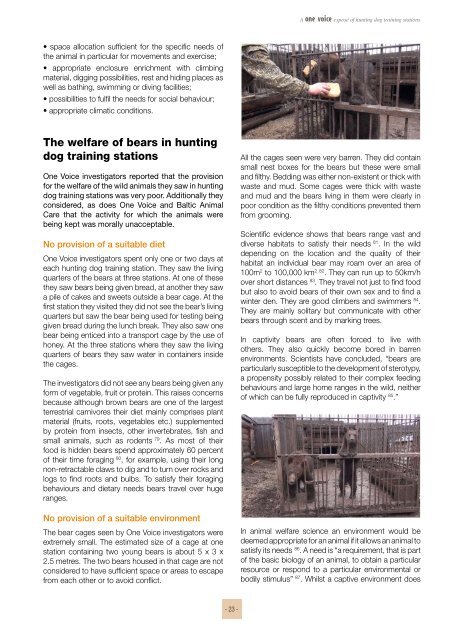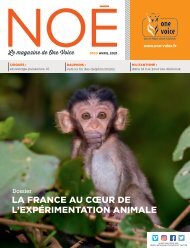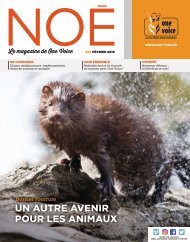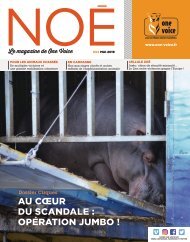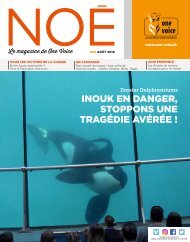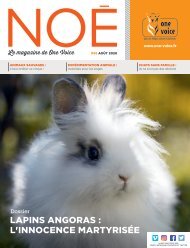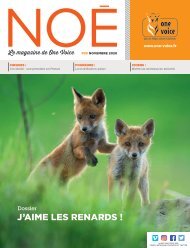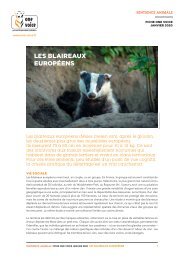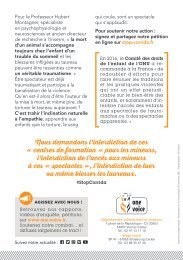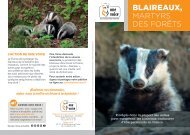The baiting of wild animals in Russia
You also want an ePaper? Increase the reach of your titles
YUMPU automatically turns print PDFs into web optimized ePapers that Google loves.
A<br />
exposé <strong>of</strong> hunt<strong>in</strong>g dog tra<strong>in</strong><strong>in</strong>g stations<br />
• space allocation sufficient for the specific needs <strong>of</strong><br />
the animal <strong>in</strong> particular for movements and exercise;<br />
• appropriate enclosure enrichment with climb<strong>in</strong>g<br />
material, digg<strong>in</strong>g possibilities, rest and hid<strong>in</strong>g places as<br />
well as bath<strong>in</strong>g, swimm<strong>in</strong>g or div<strong>in</strong>g facilities;<br />
• possibilities to fulfil the needs for social behaviour;<br />
• appropriate climatic conditions.<br />
<strong>The</strong> welfare <strong>of</strong> bears <strong>in</strong> hunt<strong>in</strong>g<br />
dog tra<strong>in</strong><strong>in</strong>g stations<br />
One Voice <strong>in</strong>vestigators reported that the provision<br />
for the welfare <strong>of</strong> the <strong>wild</strong> <strong>animals</strong> they saw <strong>in</strong> hunt<strong>in</strong>g<br />
dog tra<strong>in</strong><strong>in</strong>g stations was very poor. Additionally they<br />
considered, as does One Voice and Baltic Animal<br />
Care that the activity for which the <strong>animals</strong> were<br />
be<strong>in</strong>g kept was morally unacceptable.<br />
No provision <strong>of</strong> a suitable diet<br />
One Voice <strong>in</strong>vestigators spent only one or two days at<br />
each hunt<strong>in</strong>g dog tra<strong>in</strong><strong>in</strong>g station. <strong>The</strong>y saw the liv<strong>in</strong>g<br />
quarters <strong>of</strong> the bears at three stations. At one <strong>of</strong> these<br />
they saw bears be<strong>in</strong>g given bread, at another they saw<br />
a pile <strong>of</strong> cakes and sweets outside a bear cage. At the<br />
first station they visited they did not see the bear’s liv<strong>in</strong>g<br />
quarters but saw the bear be<strong>in</strong>g used for test<strong>in</strong>g be<strong>in</strong>g<br />
given bread dur<strong>in</strong>g the lunch break. <strong>The</strong>y also saw one<br />
bear be<strong>in</strong>g enticed <strong>in</strong>to a transport cage by the use <strong>of</strong><br />
honey. At the three stations where they saw the liv<strong>in</strong>g<br />
quarters <strong>of</strong> bears they saw water <strong>in</strong> conta<strong>in</strong>ers <strong>in</strong>side<br />
the cages.<br />
<strong>The</strong> <strong>in</strong>vestigators did not see any bears be<strong>in</strong>g given any<br />
form <strong>of</strong> vegetable, fruit or prote<strong>in</strong>. This raises concerns<br />
because although brown bears are one <strong>of</strong> the largest<br />
terrestrial carnivores their diet ma<strong>in</strong>ly comprises plant<br />
material (fruits, roots, vegetables etc.) supplemented<br />
by prote<strong>in</strong> from <strong>in</strong>sects, other <strong>in</strong>vertebrates, fish and<br />
small <strong>animals</strong>, such as rodents 79 . As most <strong>of</strong> their<br />
food is hidden bears spend approximately 60 percent<br />
<strong>of</strong> their time forag<strong>in</strong>g 80 , for example, us<strong>in</strong>g their long<br />
non-retractable claws to dig and to turn over rocks and<br />
logs to f<strong>in</strong>d roots and bulbs. To satisfy their forag<strong>in</strong>g<br />
behaviours and dietary needs bears travel over huge<br />
ranges.<br />
No provision <strong>of</strong> a suitable environment<br />
<strong>The</strong> bear cages seen by One Voice <strong>in</strong>vestigators were<br />
extremely small. <strong>The</strong> estimated size <strong>of</strong> a cage at one<br />
station conta<strong>in</strong><strong>in</strong>g two young bears is about 5 x 3 x<br />
2.5 metres. <strong>The</strong> two bears housed <strong>in</strong> that cage are not<br />
considered to have sufficient space or areas to escape<br />
from each other or to avoid conflict.<br />
All the cages seen were very barren. <strong>The</strong>y did conta<strong>in</strong><br />
small nest boxes for the bears but these were small<br />
and filthy. Bedd<strong>in</strong>g was either non-existent or thick with<br />
waste and mud. Some cages were thick with waste<br />
and mud and the bears liv<strong>in</strong>g <strong>in</strong> them were clearly <strong>in</strong><br />
poor condition as the filthy conditions prevented them<br />
from groom<strong>in</strong>g.<br />
Scientific evidence shows that bears range vast and<br />
diverse habitats to satisfy their needs 81 . In the <strong>wild</strong><br />
depend<strong>in</strong>g on the location and the quality <strong>of</strong> their<br />
habitat an <strong>in</strong>dividual bear may roam over an area <strong>of</strong><br />
100m 2 to 100,000 km 2 82 . <strong>The</strong>y can run up to 50km/h<br />
over short distances 83 . <strong>The</strong>y travel not just to f<strong>in</strong>d food<br />
but also to avoid bears <strong>of</strong> their own sex and to f<strong>in</strong>d a<br />
w<strong>in</strong>ter den. <strong>The</strong>y are good climbers and swimmers 84 .<br />
<strong>The</strong>y are ma<strong>in</strong>ly solitary but communicate with other<br />
bears through scent and by mark<strong>in</strong>g trees.<br />
In captivity bears are <strong>of</strong>ten forced to live with<br />
others. <strong>The</strong>y also quickly become bored <strong>in</strong> barren<br />
environments. Scientists have concluded, “bears are<br />
particularly susceptible to the development <strong>of</strong> sterotypy,<br />
a propensity possibly related to their complex feed<strong>in</strong>g<br />
behaviours and large home ranges <strong>in</strong> the <strong>wild</strong>, neither<br />
<strong>of</strong> which can be fully reproduced <strong>in</strong> captivity 85 .”<br />
In animal welfare science an environment would be<br />
deemed appropriate for an animal if it allows an animal to<br />
satisfy its needs 86 . A need is “a requirement, that is part<br />
<strong>of</strong> the basic biology <strong>of</strong> an animal, to obta<strong>in</strong> a particular<br />
resource or respond to a particular environmental or<br />
bodily stimulus” 87 . Whilst a captive environment does<br />
- 23 -


